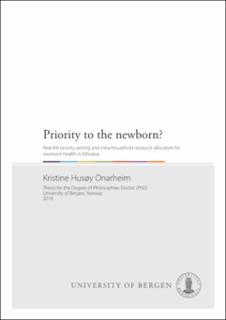| dc.description.abstract | Background: Worldwide, 2.6 million newborns die every year. Despite attention to newborn health in policies and plans in Ethiopia, coverage of services remains low, and the decline in mortality is slower than it has been for older children. The Ethiopian health care system is underfinanced, and patients and their families pay out-of-pocket for health care services. When resources for health are limited, priority setting dilemmas arise. Real-life priority setting occurs at macro, meso, and micro levels, and choices affect the health and well-being of patients and their families. At the household level, families with ill newborns make decisions about health care seeking and spending. Few have studied intra-household priorities and resource allocation when newborns fall ill. Objective: In this PhD project, I aim to describe and analyze real-life priority setting for newborn health in Ethiopia from a micro-level perspective. Methods: Study I and Study II were based on a qualitative study in Butajira, Ethiopia (autumn 2015) comprising 41 interviews, seven focus group discussions, and observation. Participants included family members experiencing newborn illness or death, health workers, and community members. Data was analyzed drawing upon qualitative content analysis. Study III was a seven-step ethical analysis of the dilemma between concerns for newborn health and family welfare described in Studies I and II. Using a stylized case of an ill newborn in a poor family, we analyzed the ethical acceptability of limiting treatment for an ill newborn to protect against financial risk. Results and discussion: Study I illustrated families’ health care decision making in a resource-constrained setting, and how and why families waited before seeking health care. Decisions to seek care at health facilities were shaped by culturally and structurally embedded understandings of the precarious newborn and families’ concerns for the survival of the family. There were gaps between local perceptions and experiences of newborn illness as opposed to academic and policy attention to newborn mortality as an avoidable problem. Study II found that families experiencing newborn illness struggled to pay out-ofpocket for expenses related to treatment, diagnostics, or use of health care services. In a context with limited welfare protection, the financial burden of health care costs had harmful effects on newborn health and households’ economic situations. In decisions about seeking health care, spending money, and adhering to medical advice, there were conflicts between concerns for the ill newborn and the family’s welfare. Study III analyzed the conflict between concerns for health benefits and financial risk protection. In the ethical analysis, we assessed available evidence and relevant regulations and laws. We looked at affected parties, their burdens and benefits, and interests and principles in conflict. If the ill newborn is seen as worse-off in terms of lifetime health, and we give weight to health maximization, then it may seem unacceptable to limit treatment. If financial risk protection is found most important, then it may be acceptable not to treat the newborn. In an all-things-considered judgment, we incline towards that it is not acceptable to restrict treatment. Yet, there is reason to believe that the newborn, family members, and health worker would value treating the newborn while avoiding financial ruin. We claim that micro-level decision makers have limited opportunities to make free choices to seek care. If we accept the dilemma, we thereby accept deprivations of people’s substantive freedoms. Conclusions: The findings illustrate that intra-household resource allocation and care-seeking for ill newborns are shaped in the intersection between socio-cultural and structural factors. The gap between local realities and national and global priorities on newborn health must be considered and underpin policy-making and implementation. The unacceptable trade-off that families and health workers face between concerns for health and welfare indicate that financial risk protection is key on the path to universal health coverage, in particular for high-priority services. Studies of real-life ethical dilemmas are crucial to understanding the present, and as a starting point to improve health, welfare, and fairer priority setting. | en_US |
| dc.relation.haspart | Paper II: Onarheim KH, Sisay MM, Gizaw M, Norheim OF, Moland KM, Miljeteig I. Selling my sheep to pay for medicines ‒ Household priorities and coping strategies in a setting without universal health coverage. BMC Health Services Research. 2018;18:153. The article is available at: <a href="http://hdl.handle.net/1956/17612" target="blank">http://hdl.handle.net/1956/17612</a> | en_US |

